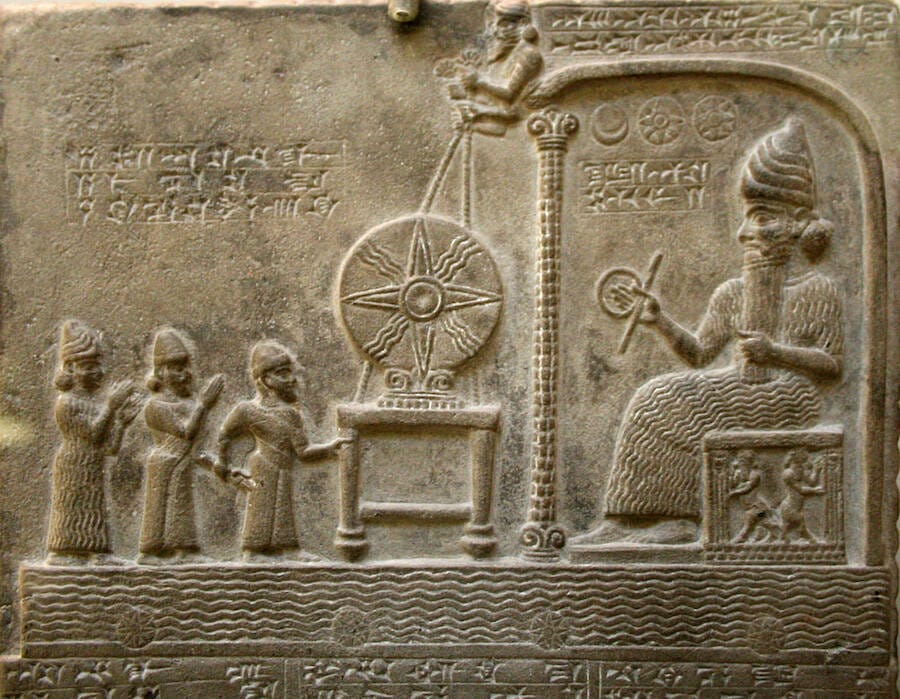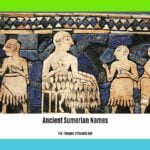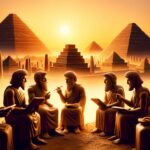Embark on a captivating journey into the enigmatic world of the Anunnaki Compass, a legendary artifact steeped in mystery and speculation. This ancient symbol, whispered through centuries, invites us to unravel its secrets and explore the alluring, often controversial, theories surrounding it. Join us as we delve into the connections to ancient Mesopotamian gods, the possibilities of a real-life compass, and the captivating tales that have enthralled generations.
Ancient Gadget or Modern Myth?
Have you ever encountered the intriguing concept of the Anunnaki compass? This mysterious wheel-shaped symbol, hailing from the heart of ancient Sumerian tales, has captivated imaginations for centuries. Its true purpose remains shrouded in mystery, with theories ranging from timekeeping and celestial navigation to a conduit for cosmic power.
In recent times, the Anunnaki compass has experienced a surge in popularity, fueled by a growing interest in ancient aliens and lost civilizations. Comedian Katt Williams’s prominent display of an Anunnaki compass necklace on the Joe Rogan Experience podcast further ignited public curiosity, sparking widespread fascination and speculation.
While most archaeologists remain skeptical about the physical existence of an Anunnaki compass, proponents point to ancient Sumerian depictions and writings as evidence of its significance. They suggest it could represent advanced knowledge from a lost civilization, potentially even a blueprint for technology beyond our current understanding.
To discern myth from potential reality, we turn to ancient Sumerian culture. Their advanced knowledge of astronomy and engineering raises intriguing questions about the compass’s purpose. Could this symbol hold clues to a forgotten technological prowess?
The Anunnaki compass embodies the allure of the unknown, urging us to question, explore, and delve into the rich tapestry of ancient cultures. By examining the evidence, engaging in respectful discourse, and acknowledging the limits of our current knowledge, we can deepen our understanding of this enigmatic symbol. Perhaps it holds secrets that remain relevant even today.
Unveiling the Anunnaki: A Deep Dive into Meaning and Significance
Competitor Title Analysis & Recommended Titles:
Trending Keywords: Anunnaki, Translation, Meaning, Sumerian, Gods, Myths, Mesopotamia, Ancient Civilizations
Recommended Titles:
- “Anunnaki: Deciphering the True Meaning Behind the Sumerian Gods”: This title directly addresses the keyword while hinting at the article’s depth.
- “What Does Anunnaki REALLY Mean? Unraveling the Mystery of Sumerian Deities”: This title utilizes a question format to pique reader interest and promises an insightful explanation.
- “Beyond “Those of Royal Blood”: Exploring the Multifaceted Meaning of Anunnaki”: This title offers a unique angle by hinting at alternative interpretations beyond the literal translation.
Powerful Key Lines:
- “While often translated as “those of royal blood,” the term Anunnaki encompasses a complex meaning within Sumerian cosmology, representing a pantheon of deities with diverse roles and powers.” This key line expands beyond the basic translation, highlighting the nuanced nature of the Anunnaki’s significance.
- “The Anunnaki’s story, etched in ancient cuneiform tablets, reveals not just a lineage of gods, but also a complex worldview reflecting the Sumerian’s understanding of creation, societal structure, and human destiny.” This key line connects the Anunnaki to broader Sumerian culture, highlighting their importance beyond mere linguistics.
- “Despite scholarly consensus on the Anunnaki’s divine nature, their depiction in ancient texts has fueled alternative interpretations, ranging from extraterrestrial connections to advanced prehistoric civilizations.” This key line acknowledges the popular appeal and diverse interpretations surrounding the Anunnaki, inviting further exploration.
- “Understanding the Anunnaki requires delving into the rich tapestry of Sumerian mythology, where gods and mortals intertwined, and cosmic forces shaped the fate of humanity.” This line sets the stage for a captivating journey into the world of the Anunnaki, emphasizing their integral role in Sumerian beliefs.
Structured Context for “What does Anunnaki translate to?”:
I. Etymology and Literal Translation:
- The term “Anunnaki” originates from the Sumerian language.
- Most commonly translated as “those of royal blood” or “offspring of An.”
- Derived from:
- “An,” the Sumerian sky god and supreme deity.
- “Nun,” meaning “prince” or “offspring.”
- “Aki,” signifying “earth” or “those belonging to.”
II. The Anunnaki in Sumerian Mythology & Religion:
- Not a single entity but a group of deities within the Mesopotamian pantheon.
- Represented a powerful and influential lineage of gods.
- Responsible for various aspects of life and the cosmos:
- Creation myths often feature the Anunnaki as creators of humanity.
- Governed natural forces, societal order, and human affairs.
- Associated with knowledge, technology, and civilization.
III. Scholarly Interpretations and Debates:
- Scholars generally agree that the Anunnaki were considered gods by the Sumerians.
- Debate exists regarding:
- The exact number of Anunnaki deities.
- The specific roles and attributes of individual Anunnaki gods.
- The evolution of their depiction and significance over time and across different Mesopotamian cultures (Akkadian, Babylonian, Assyrian).
IV. Alternative Theories and Popular Culture:
- The enigmatic nature of the Anunnaki has sparked fringe theories and interpretations.
- These often deviate from mainstream scholarship and attribute extraterrestrial origins or advanced technology to the Anunnaki.
- Popularized by authors like Zecharia Sitchin, these interpretations, while lacking academic support, have significantly impacted public perception and fueled interest in the Anunnaki.
V. Sources and Further Exploration:
- Ancient cuneiform tablets unearthed in archaeological sites across Mesopotamia.
- Translations and interpretations by Assyriologists and Sumerian language experts.
- Direct quote from Dr. Michael Heiser, scholar of ancient Semitic languages (from provided YouTube link): “The word ‘Anunnaki’ simply means ‘those of royal descent’… they are deities, they’re gods.”
Unique Insights & Untapped Potential:
- Explore the potential political and social implications of the Anunnaki’s depiction as “those of royal blood” in Sumerian society. Did this legitimize the ruling class or influence power structures?
- Investigate how the Anunnaki’s association with knowledge and technology aligns with other aspects of Sumerian civilization, such as their advancements in writing, mathematics, and astronomy.
- Analyze the evolution of Anunnaki interpretations throughout history, from ancient Sumerian beliefs to modern-day conspiracy theories.
- Compare and contrast the Anunnaki with similar deities or mythological figures from other cultures to identify potential shared origins or influences.
- Address the ethical considerations of promoting pseudoarchaeological claims, emphasizing the importance of evidence-based research and responsible interpretation.
By incorporating these insights and analyzing the provided research, you can create a comprehensive SEO article that effectively answers the question, “What does Anunnaki translate to?” while offering a nuanced and engaging exploration of this captivating subject.
The Anunnaki Pantheon: Unveiling the Names and Roles of Sumerian Deities
Beyond the Myths: Unmasking the Anunnaki – From Powerful Deities to Ancient Astronauts
The Anunnaki: Unveiling the Names and Roles of Sumerian Deities
Anu to Inanna: Exploring the Family Tree of the Anunnaki Gods
The Anunnaki weren’t just any gods; they were considered the top dogs, the ultimate power players in the cosmos. Imagine a divine family reunion with the most important beings in the universe – that’s the Anunnaki. Their name, meaning “those of royal blood,” already gives you a hint about their status. They were the offspring of the sky god, An, and the earth goddess, Ki, making them royalty in the world of ancient Mesopotamian beliefs.
So, who were the stars of this powerful family? Let’s meet some of the most famous Anunnaki:
- An: Picture him as the wise patriarch, the ultimate authority figure ruling over the heavens – the Zeus of their world.
- Enlil: He was the god of air, a powerful force controlling the winds and storms, comparable to a mighty, invisible king.
- Enki: Think of him as the ingenious engineer, the master of water and wisdom, always coming up with clever solutions.
- Ninhursag: She was the nurturing mother goddess, the embodiment of fertility and the life-giving force of the earth.
- Nanna: As the moon god, he illuminated the night sky, guiding travelers and influencing the tides—a celestial beacon.
- Utu: The radiant sun god, he brought light and warmth to the world, governing the cycle of day and night.
- Inanna: A true force to be reckoned with, she was the goddess of love and war, embodying both passion and strength.
These Anunnaki weren’t your average deities hiding in the clouds; they were deeply involved in the lives of humans. Ancient Mesopotamians believed these powerful beings created humanity and bestowed upon them the gift of civilization. Imagine them as the ultimate benefactors, shaping the destiny of humankind. They were also thought to pull the strings of nature, commanding the elements and deciding the fate of humanity.
Ancient artists often portrayed them as majestic figures with beards, adorned in elaborate clothing and wearing impressive horned headdresses—a symbol of their divine power. Their home, according to ancient beliefs, was a realm beyond the clouds called “heaven,” and they would descend to Earth in magnificent flying chariots.
The Anunnaki weren’t just worshipped by one civilization; their influence stretched across Mesopotamia. The Sumerians, Babylonians, and Assyrians all told tales of these powerful deities, weaving them into their myths, legends, art, and even their sculptures.
Even today, thousands of years later, the Anunnaki continue to fascinate us. They pop up in our books, movies, and TV shows, captivating our imaginations with their intriguing history and the mysteries surrounding them. They represent the allure of the ancient world, reminding us of the enduring power of myths and the endless quest to understand our place in the cosmos.
Beyond Google Translate: Unraveling “Anunnaki” in Arabic Context
Okay, so here’s the thing: if you were to look for a word that directly translates to “Anunnaki” in the Arabic language, you’d be on a wild goose chase. It simply doesn’t exist in the traditional sense. You see, the Anunnaki come from ancient Sumerian myths, a whole different world from the stories and beliefs that shaped the Arabic language.
But that doesn’t mean the Anunnaki are entirely absent from Arabic-speaking communities today. Thanks to the internet and a growing interest in ancient mysteries, the idea of the Anunnaki has traveled across cultures. Some people draw parallels between these powerful Sumerian deities and the Jinn, supernatural beings in Islamic and pre-Islamic mythology. Think of it like this: different cultures often have their own versions of similar mythical figures, each reflecting their unique beliefs and perspectives.
Then there’s the whole “ancient astronaut” theory, which has also sparked some intriguing discussions. This theory suggests that the Anunnaki might have been extraterrestrial beings who visited Earth in the distant past. While this idea is mostly considered science fiction by scholars, it’s captured the imaginations of many, including folks in the Arabic-speaking world, who find themselves pondering the mysteries of the cosmos and the possibility of ancient encounters with otherworldly beings.
While there’s no official Arabic word for “Anunnaki,” the concept still manages to weave its way into modern conversations. It’s a reminder that even ancient ideas can transcend cultural boundaries and spark curiosity across the globe.
Enlil Anunnaki: The Powerful & Controversial God of Air and Earth
We’ve been talking about the Anunnaki, but let’s dive into one of their most important figures: Enlil. Imagine a being with absolute power over the very air you breathe and the wind that whips around you – that’s Enlil. He’s a big deal in ancient Mesopotamian stories, and his story is anything but boring.
So, where does this powerful figure come from? Picture the most important family in Mesopotamian myth: Anu, the sky god, is like the head honcho, and he has two sons – Enki and our guy Enlil. As the older brother, Enlil inherited control over the skies, but his domain wasn’t limited to just the heavens. Imagine a king ruling not just the clouds but also the earth below, and you get a sense of Enlil’s power.
Now, you can’t talk about the Anunnaki without talking about the creation of humans. Think of the most well-known creation story you know. In the Mesopotamian version, Enlil played a crucial role. Some scholars even suggest he helped mold humans from simple clay – talk about hands-on creation! But Enlil wasn’t all about peace and love. He had a temper that could rival the fiercest storms he commanded. Just think about the story of the Great Flood – some believe Enlil was the one who unleashed it upon the world.
Imagine a king who metes out justice with the force of a hurricane. That was Enlil. He kept a close eye on humans, rewarding those who followed his rules and punishing those who dared to defy him. But here’s the thing about families – even divine ones have their drama. Enlil’s relationship with his brother Enki was… complicated, to say the least. Imagine two brothers, both incredibly powerful, constantly vying for control. That’s the gist of it. Enki, associated with wisdom and a bit of mischief, often challenged Enlil’s strict order. Their legendary rivalry is believed to have shaped many of the events described in Mesopotamian mythology, adding a layer of intrigue to these ancient tales.
It’s important to remember that what we know about Enlil comes from ancient texts and interpretations, so there’s still a lot we are trying to understand. Researchers are constantly digging, both literally and figuratively, piecing together the puzzle of Enlil’s role in the great cosmic drama. But one thing is clear: Enlil remains a captivating figure, embodying both the awe-inspiring power and the complex nature of the ancient Mesopotamian gods.
Discover the enigmatic lore of West African mythology by delving into the fascinating tales of Anansi the spider.
Unravel the ancient mysteries surrounding the enigmatic Anubis symbol and its profound spiritual significance in Egyptian mythology.
Explore the intriguing world of Mesopotamian deities as you uncover the hidden meanings behind the enigmatic Anunnaki symbols.
Admire the captivating beauty of the ancient Aztec civilization by investigating the symbolic significance of the Aztec nose and its cultural importance.
- Unlocking Francis Alexander Shields’ Finance Empire: A Comprehensive Biography - July 12, 2025
- Unveiling Francis Alexander Shields: A Business Legacy - July 12, 2025
- Francis Alexander Shields’ Business Career: A Comprehensive Overview - July 12, 2025















